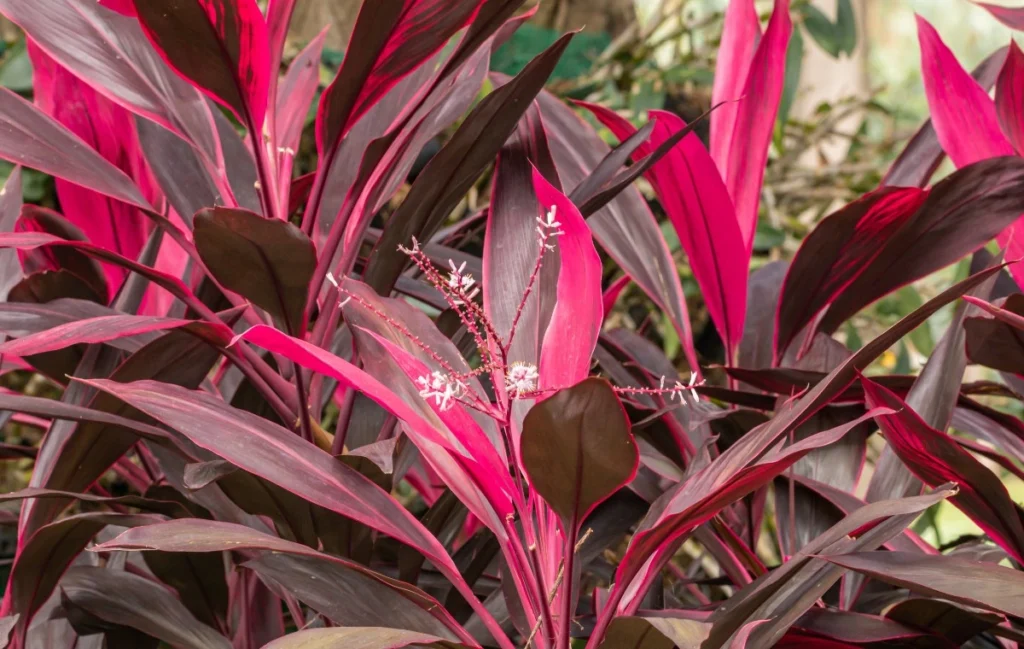The Ti Plant (Cordyline fruticosa) belongs to the Asparagaceae family and it is closely related to Dracaenas and Asparagus. It originates from Southeast Asia, Papua New Guinea, Melanesia, northeastern Australia, as well as the Polynesian islands and other islands in the Indian Ocean.
The genus name Cordyline derives from the Greek word “kordyle,” meaning “club” or “stick,” referring to the shape of its thickened rhizome. The specific epithet fruticosa comes from the Latin “fruticosus,” and contrary to what it seems, it does not refer to the plant’s fruits but means “shrubby” or “full of shoots,” highlighting the growth habit of the species, which frequently forms branched shrubs.

Due to its decorative effect, it has conquered tropical gardens worldwide, and today many varieties can be found beyond the original typical species. With a woody texture and shrubby habit, it usually has only one trunk or a few branches, and beautiful, very shiny, leathery, and broad leaves, in green, red, or purple, in solid colors or with variegations of white, yellow, pink, and red.
The inflorescence, a panicle type, appears on adult individuals at any time of the year, showcasing small, delicate yellow or pink flowers with a delicate fragrance. The fruits that form are berries, turning red when ripe.

There are many cultivars of Ti Plant, selected for their foliage. Among these, we can mention ‘Firebrand’, perhaps one of the most popular, with reddish-purple leaves; ‘Tricolor’, with leaves marked in green, pink, and cream-yellow; ‘Amabilis’ with oval and broad leaves speckled with pink and white; ‘Baptisii’, with recurved leaves marked with pink and yellow; ‘Black Mystique’, with intense purple, almost black color; and ‘Hawaian Bonsai’, with crimson leaves and does not exceed 3.3 feet (one meter) in height.
A stunning foliage that adds a delightful tropical feel to the garden, this is how we can characterize the landscaping use of the Ti Plant. The vibrant and varied colors are perfect for adding beautiful contrasts year-round. It can be used in dense borders and masses, in tropical and contemporary gardens. Even isolated, as a focal point, or in conjunction with other species, it is often used in pots, as foliage, adorning well-lit indoor environments, such as homes, offices, and shopping centers.
Polynesians and Hawaiians developed many ways to use the Ti Plant beyond its ornamental use. The plant’s rhizomes are rich in starch and used as food. The leaves serve a multitude of purposes, from roofing houses, making traditional clothing (hulas), alcoholic beverages, and even as “toilet paper.”

They should be cultivated in full sun or partial shade, in fertile, well-drained soil enriched with organic matter and regularly watered. This species tolerates cold and the salinity of coastal regions. The colorful varieties look more beautiful and with more vivid colors when grown in full sun.
It does not withstand drought or low humidity; however, it should not be waterlogged, under the penalty of damaging the roots. It resents environments with air conditioning. Preferably water with fluoride-free water (use rainwater instead of tap water), as fluoride causes stains on its leaves. Apply fertilizers during the growth period, but be careful not to let the fertilizer touch the leaves.
Cordyline fruticosa multiplies easily by cuttings, in addition to shoots that spontaneously emerge directly from the rhizome around the mother plant, thus preserving the cultivar’s characteristics. Reproduction by cuttings is carried out by cutting mature segments of the plant’s stem, placed to sprout in a substrate kept moist, under filtered shade. After sprouting, a cut is made in the sprouted region and replanted in pots for rooting. Reproduction by seeds is rarer and often results in individuals different from the mother plant. The germination rate is high and takes one to three months to complete.



